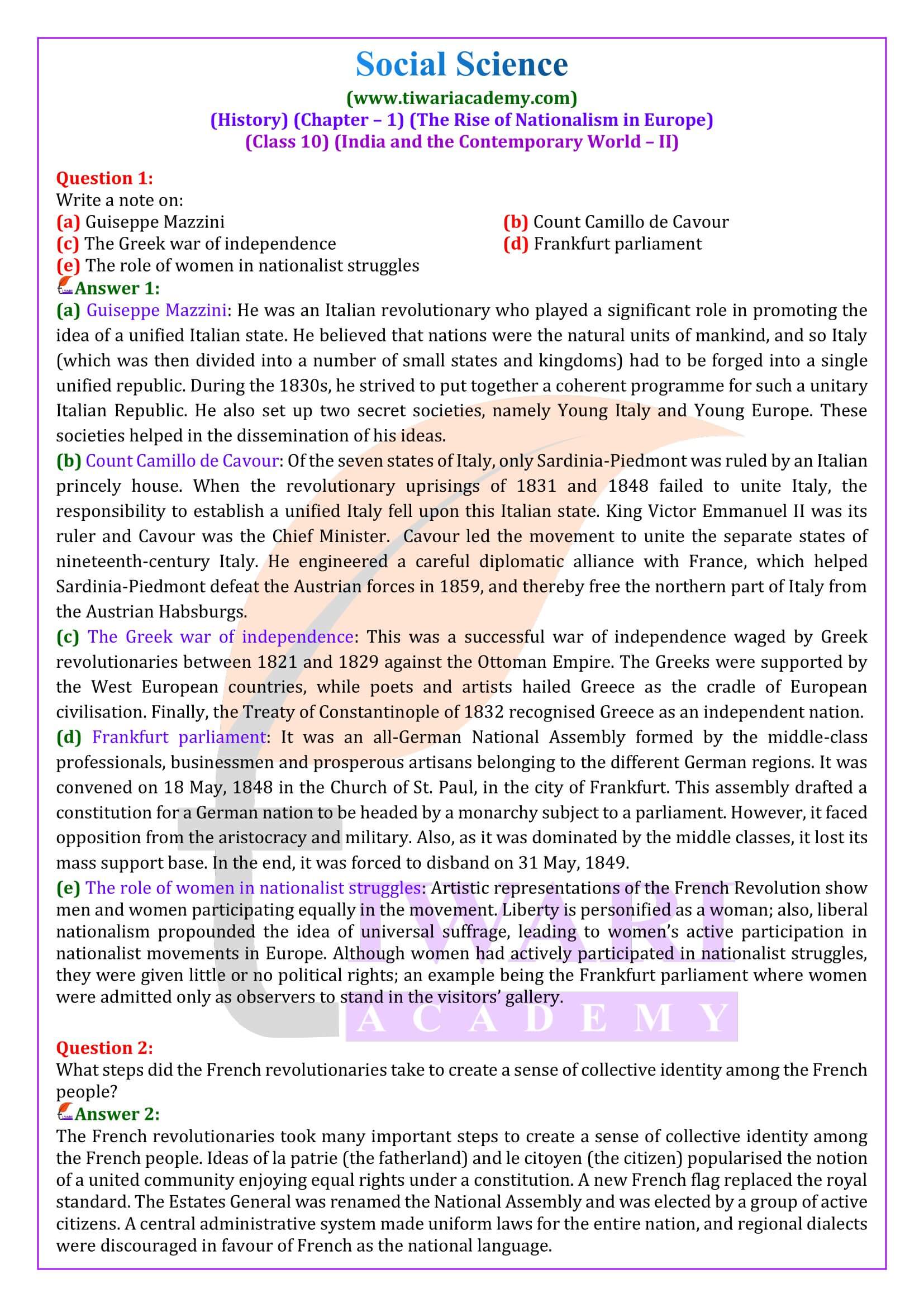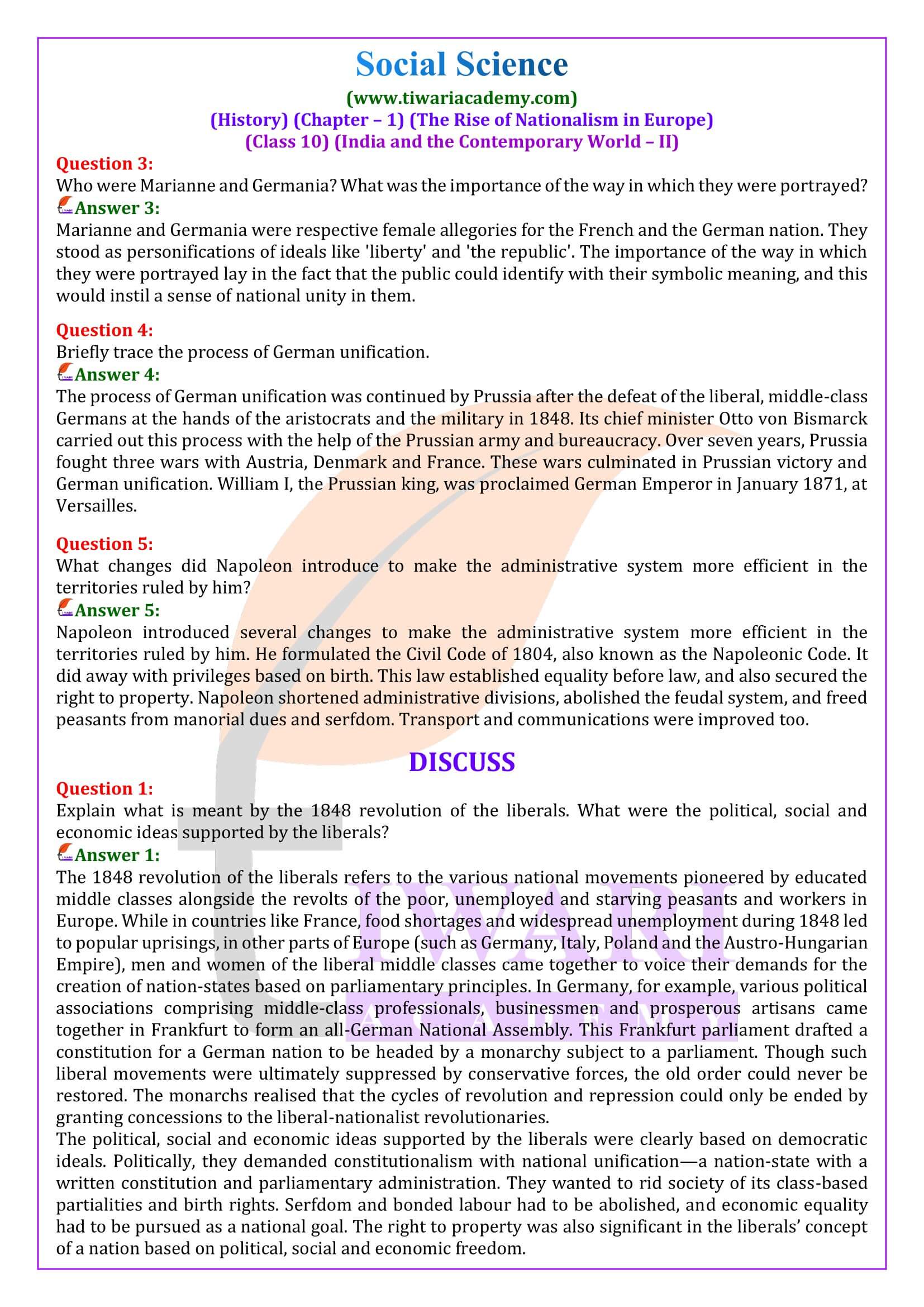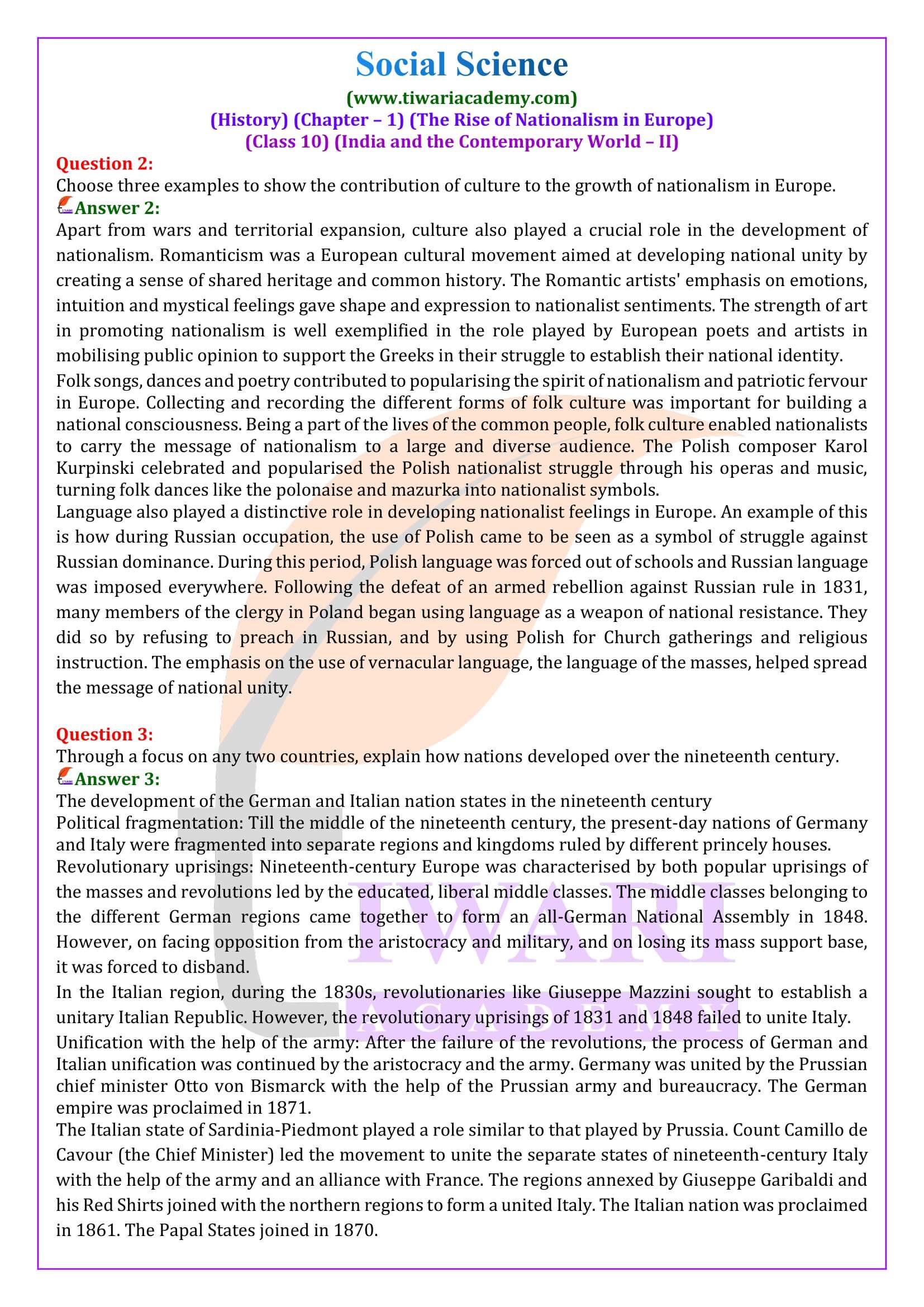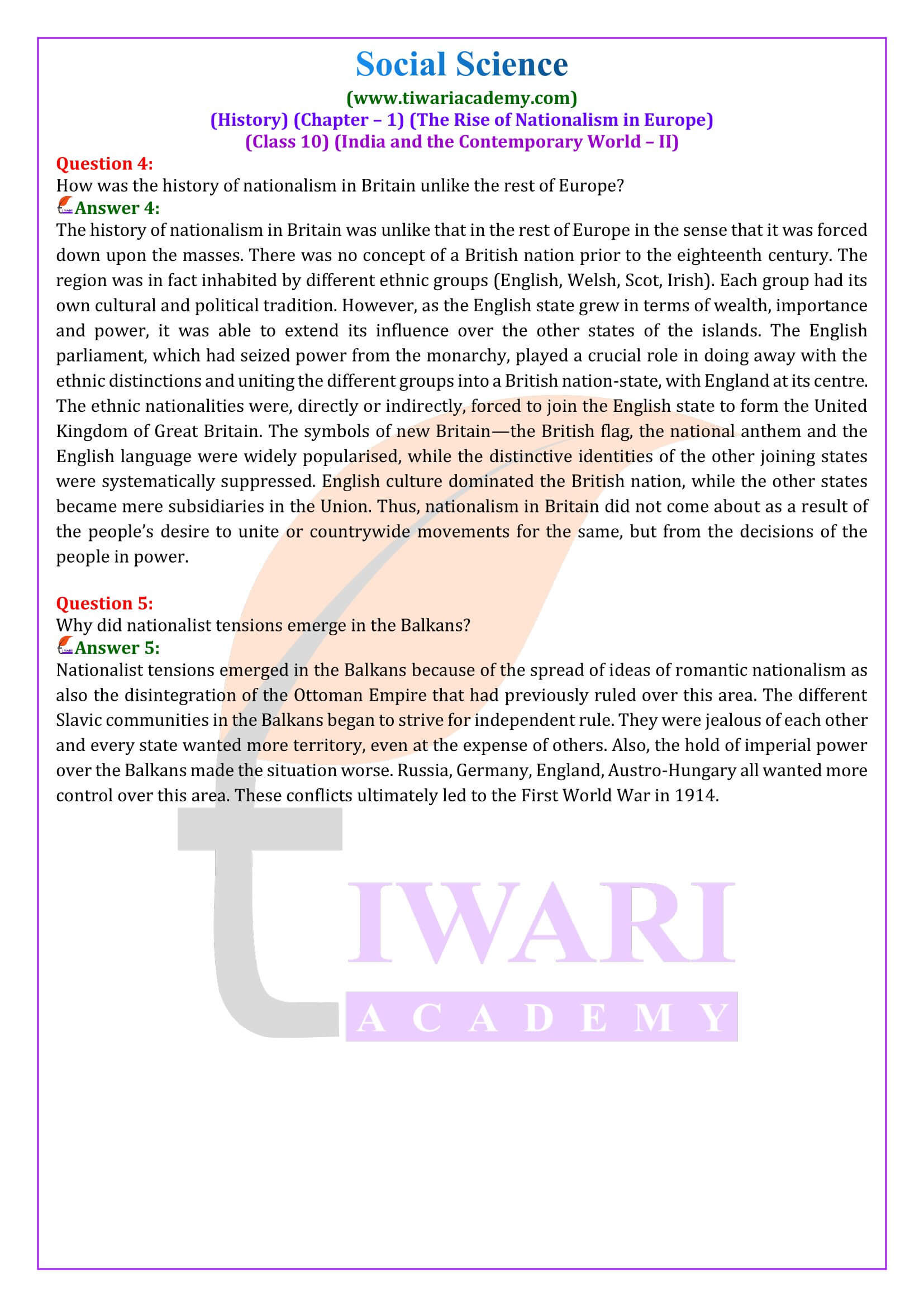NCERT Solutions for Class 10 History Chapter 1 The Rise of Nationalism in Europe in PDF file format with supporting Study Material in English and Hindi Medium updated for new academic session 2025-26 for new academic year. Download Solutions and study material for offline use based on new NCERT Textbook and new CBSE Curriculum for current academic year.
NCERT Solutions for Class 10 History Chapter 1
NCERT Solutions for Class 10 History Chapter 1
| Class: | 10 |
| Subject: | Social Science – History |
| Chapter 1: | The Rise of Nationalism in Europe |
| Session: | 2025-26 |
Class 10 History Chapter 1 The Rise of Nationalism
NCERT Solutions for Class 10 History Chapter 1 in PDF form free to download is given below. NCERT Solutions as well as Offline Apps are updated for new academic session 2025-26 based on new NCERT Books and latest CBSE Syllabus.
Exatra Questions Class 10 History Chapter 1
What is meant by Absolutist?
It is Literally, a government or system of rule that has no restraints on the power exercised. in history, the term refers to a form of monarchical government that was centralized, militarized and repressive.
What do you understand by Utopian?
It is a vision of a society that is so ideal that it is unlikely to actually exist.
What is Plebiscite?
Plebiscite is a direct vote by which all the people of a region are asked to accept or reject a proposal.
What is Conservatism?
It is a political philosophy that stressed the importance of tradition, established institutions and customs, and preferred gradual development to quick change.
When was Zollverein formed?
Zollverein was formed at the initiative of Prussia and joined by most of the German States. The union abolished tariff barriers and reduce the number of currencies from over thirty to two.
What does Romanticism refer?
It refers a cultural movement which sought to develop a particular form of Nationalist sentiment.
One Mark Questions with Answers
1. Which Treaty recognised Greece as an independent Nation?
2. Who was Earnest Renan?
3. What was the allegory of German States?
4. Which priniciple was propounded by Montesquieu?
5. Name the personality related to Vienna Congress?
6. What was zollverein? How was it responsible for economic unification of Germany?
7. Who spearheaded the protestant movement in Ireland?
8. Name the region whose inhabitants were broadly known as Slavs?
9. Which Treaty was signed to bring about an end the changes brought about by Napoleonic Wars?
10. In which year Vienna Congress was held?
Answers of 1 Mark Questions
1. Treaty of Constantinople
2. French Philosopher
3. Germania Heroism
4. Separation of Powers
5. Duke Metternich
6. It was a German Customs Union which abolished tariff barriers
7. Wolfe Tone
8. Balkans
9. Vienna Congress
10. 1815
Important Terms Related to Chapter 1
1. In the 18th century Germany, Italy, Switzerland was divided into many states and each had an independent ruler. French Revolution It was the first expression of nationalism. It ended
monarchy in France and gave power to the citizens.
2. Revolutionary France mark the first political experiment in liberal democracy, the right to vote and to get elected was granted exclusively to property owning men.
3. Napoleonic code of 1804: It did away with all privileges based on birth, established equality before the law and secured the right to property.
4. Vienna Congress in 1815: representatives of the European powers – Britain, Russia, Prussia and Austria – who had collectively defeated Napoleon, met at Vienna to draw up a settlement for Europe.
5. The Congress was hosted by the Austrian Chancellor Duke Metternich.
6. In January 1871, the Prussian king, William I, was proclaimed German Emperor in a ceremony held at Versailles.
7. In 1861 Victor Emmanuel II was proclaimed king of united Italy.
8. Women had form their own political associations, founded newspapers and taking part in political meeting and demonstrations. Despite this they were denied suffrage right during the election of the assembly.
Ask your doubts related to NIOS or CBSE Board and share your knowledge with your friends and other users through Discussion Forum. Download CBSE NCERT Books and Apps for offline use.
Important Questions on Class 10 History Chapter 1
Who was Guiseppe Mazzini?
He was an Italian revolutionary who played a significant role in promoting the idea of a unified Italian state. He believed that nations were the natural units of mankind, and so Italy (which was then divided into a number of small states and kingdoms) had to be forged into a single unified republic. During the 1830s, he strived to put together a coherent programme for such a unitary Italian Republic. He also set up two secret societies, namely Young Italy and Young Europe. These societies helped in the dissemination of his ideas.
What do you know about Count Camillo de Cavour?
Of the seven states of Italy, only Sardinia-Piedmont was ruled by an Italian princely house. When the revolutionary uprisings of 1831 and 1848 failed to unite Italy, the responsibility to establish a unified Italy fell upon this Italian state. King Victor Emmanuel II was its ruler and Cavour was the Chief Minister. Cavour led the movement to unite the separate states of nineteenth-century Italy. He engineered a careful diplomatic alliance with France, which helped Sardinia-Piedmont defeat the Austrian forces in 1859, and thereby free the northern part of Italy from the Austrian Habsburgs.
What was the Greek war of independence?
This was a successful war of independence waged by Greek revolutionaries between 1821 and 1829 against the Ottoman Empire. The Greeks were supported by the West European countries, while poets and artists hailed Greece as the cradle of European civilisation. Finally, the Treaty of Constantinople of 1832 recognised Greece as an independent nation.
What do you know about Frankfurt parliament?
It was an all-German National Assembly formed by the middle-class professionals, businessmen and prosperous artisans belonging to the different German regions. It was convened on 18 May, 1848 in the Church of St. Paul, in the city of Frankfurt. This assembly drafted a constitution for a German nation to be headed by a monarchy subject to a parliament. However, it faced opposition from the aristocracy and military. Also, as it was dominated by the middle classes, it lost its mass support base. In the end, it was forced to disband on 31 May, 1849.
What was the role of women in nationalist struggles?
Artistic representations of the French Revolution show men and women participating equally in the movement. Liberty is personified as a woman; also, liberal nationalism propounded the idea of universal suffrage, leading to women’s active participation in nationalist movements in Europe. Although women had actively participated in nationalist struggles, they were given little or no political rights; an example being the Frankfurt parliament where women were admitted only as observers to stand in the visitors’ gallery.
What steps did the French revolutionaries take to create a sense of collective identity among the French people?
The French revolutionaries took many important steps to create a sense of collective identity among the French people. Ideas of la patrie (the fatherland) and le citoyen (the citizen) popularised the notion of a united community enjoying equal rights under a constitution. A new French flag replaced the royal standard. The Estates General was renamed the National Assembly and was elected by a group of active citizens. A central administrative system made uniform laws for the entire nation, and regional dialects were discouraged in favour of French as the national language.
Who were Marianne and Germania? What was the importance of the way in which they were portrayed?
Marianne and Germania were respective female allegories for the French and the German nation. They stood as personifications of ideals like ‘liberty’ and ‘the republic’. The importance of the way in which they were portrayed lay in the fact that the public could identify with their symbolic meaning, and this would instil a sense of national unity in them.
Briefly trace the process of German unification.
The process of German unification was continued by Prussia after the defeat of the liberal, middle-class Germans at the hands of the aristocrats and the military in 1848. Its chief minister Otto von Bismarck carried out this process with the help of the Prussian army and bureaucracy. Over seven years, Prussia fought three wars with Austria, Denmark and France. These wars culminated in Prussian victory and German unification. William I, the Prussian king, was proclaimed German Emperor in January 1871, at Versailles.
What changes did Napoleon introduce to make the administrative system more efficient in the territories ruled by him?
Napoleon introduced several changes to make the administrative system more efficient in the territories ruled by him. He formulated the Civil Code of 1804, also known as the Napoleonic Code. It did away with privileges based on birth. This law established equality before law, and also secured the right to property. Napoleon shortened administrative divisions, abolished the feudal system, and freed peasants from manorial dues and serfdom. Transport and communications were improved too.
The 1848 revolution of the liberals refers to the various national movements pioneered by educated middle classes alongside the revolts of the poor, unemployed and starving peasants and workers in Europe. While in countries like France, food shortages and widespread unemployment during 1848 led to popular uprisings, in other parts of Europe (such as Germany, Italy, Poland and the Austro-Hungarian Empire), men and women of the liberal middle classes came together to voice their demands for the creation of nation-states based on parliamentary principles. In Germany, for example, various political associations comprising middle-class professionals, businessmen and prosperous artisans came together in Frankfurt to form an all-German National Assembly. This Frankfurt parliament drafted a constitution for a German nation to be headed by a monarchy subject to a parliament. Though such liberal movements were ultimately suppressed by conservative forces, the old order could never be restored. The monarchs realised that the cycles of revolution and repression could only be ended by granting concessions to the liberal-nationalist revolutionaries. The political, social and economic ideas supported by the liberals were clearly based on democratic ideals. Politically, they demanded constitutionalism with national unification—a nation-state with a written constitution and parliamentary administration. They wanted to rid society of its class-based partialities and birth rights. Serfdom and bonded labour had to be abolished, and economic equality had to be pursued as a national goal. The right to property was also significant in the liberals’ concept of a nation based on political, social and economic freedom.
Choose three examples to show the contribution of culture to the growth of nationalism in Europe.
Apart from wars and territorial expansion, culture also played a crucial role in the development of nationalism. Romanticism was a European cultural movement aimed at developing national unity by creating a sense of shared heritage and common history. The Romantic artists’ emphasis on emotions, intuition and mystical feelings gave shape and expression to nationalist sentiments. The strength of art in promoting nationalism is well exemplified in the role played by European poets and artists in mobilising public opinion to support the Greeks in their struggle to establish their national identity. Folk songs, dances and poetry contributed to popularising the spirit of nationalism and patriotic fervour in Europe. Collecting and recording the different forms of folk culture was important for building a national consciousness. Being a part of the lives of the common people, folk culture enabled nationalists to carry the message of nationalism to a large and diverse audience. The Polish composer Karol Kurpinski celebrated and popularised the Polish nationalist struggle through his operas and music, turning folk dances like the polonaise and mazurka into nationalist symbols. Language also played a distinctive role in developing nationalist feelings in Europe. An example of this is how during Russian occupation, the use of Polish came to be seen as a symbol of struggle against Russian dominance. During this period, Polish language was forced out of schools and Russian language was imposed everywhere. Following the defeat of an armed rebellion against Russian rule in 1831, many members of the clergy in Poland began using language as a weapon of national resistance. They did so by refusing to preach in Russian, and by using Polish for Church gatherings and religious instruction. The emphasis on the use of vernacular language, the language of the masses, helped spread the message of national unity.
Through a focus on any two countries, explain how nations developed over the nineteenth century.
The development of the German and Italian nation states in the nineteenth century Political fragmentation: Till the middle of the nineteenth century, the present-day nations of Germany and Italy were fragmented into separate regions and kingdoms ruled by different princely houses. Revolutionary uprisings: Nineteenth-century Europe was characterised by both popular uprisings of the masses and revolutions led by the educated, liberal middle classes. The middle classes belonging to the different German regions came together to form an all-German National Assembly in 1848. However, on facing opposition from the aristocracy and military, and on losing its mass support base, it was forced to disband. In the Italian region, during the 1830s, revolutionaries like Giuseppe Mazzini sought to establish a unitary Italian Republic. However, the revolutionary uprisings of 1831 and 1848 failed to unite Italy. Unification with the help of the army: After the failure of the revolutions, the process of German and Italian unification was continued by the aristocracy and the army. Germany was united by the Prussian chief minister Otto von Bismarck with the help of the Prussian army and bureaucracy. The German empire was proclaimed in 1871. The Italian state of Sardinia-Piedmont played a role similar to that played by Prussia. Count Camillo de Cavour (the Chief Minister) led the movement to unite the separate states of nineteenth-century Italy with the help of the army and an alliance with France. The regions annexed by Giuseppe Garibaldi and his Red Shirts joined with the northern regions to form a united Italy. The Italian nation was proclaimed in 1861. The Papal States joined in 1870.
How was the history of nationalism in Britain unlike the rest of Europe?
The history of nationalism in Britain was unlike that in the rest of Europe in the sense that it was forced down upon the masses. There was no concept of a British nation prior to the eighteenth century. The region was in fact inhabited by different ethnic groups (English, Welsh, Scot, Irish). Each group had its own cultural and political tradition. However, as the English state grew in terms of wealth, importance and power, it was able to extend its influence over the other states of the islands. The English parliament, which had seized power from the monarchy, played a crucial role in doing away with the ethnic distinctions and uniting the different groups into a British nation-state, with England at its centre. The ethnic nationalities were, directly or indirectly, forced to join the English state to form the United Kingdom of Great Britain. The symbols of new Britain—the British flag, the national anthem and the English language were widely popularised, while the distinctive identities of the other joining states were systematically suppressed. English culture dominated the British nation, while the other states became mere subsidiaries in the Union. Thus, nationalism in Britain did not come about as a result of the people’s desire to unite or countrywide movements for the same, but from the decisions of the people in power.
Why did nationalist tensions emerge in the Balkans?
Nationalist tensions emerged in the Balkans because of the spread of ideas of romantic nationalism as also the disintegration of the Ottoman Empire that had previously ruled over this area. The different Slavic communities in the Balkans began to strive for independent rule. They were jealous of each other and every state wanted more territory, even at the expense of others. Also, the hold of imperial power over the Balkans made the situation worse. Russia, Germany, England, Austro-Hungary all wanted more control over this area. These conflicts ultimately led to the First World War in 1914.







